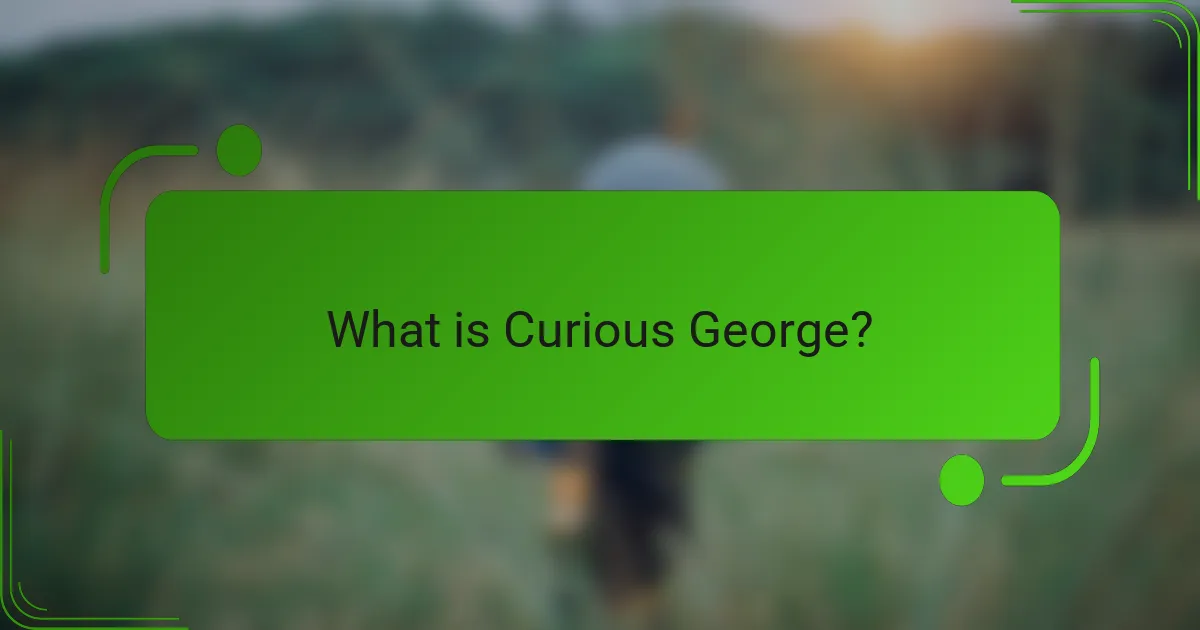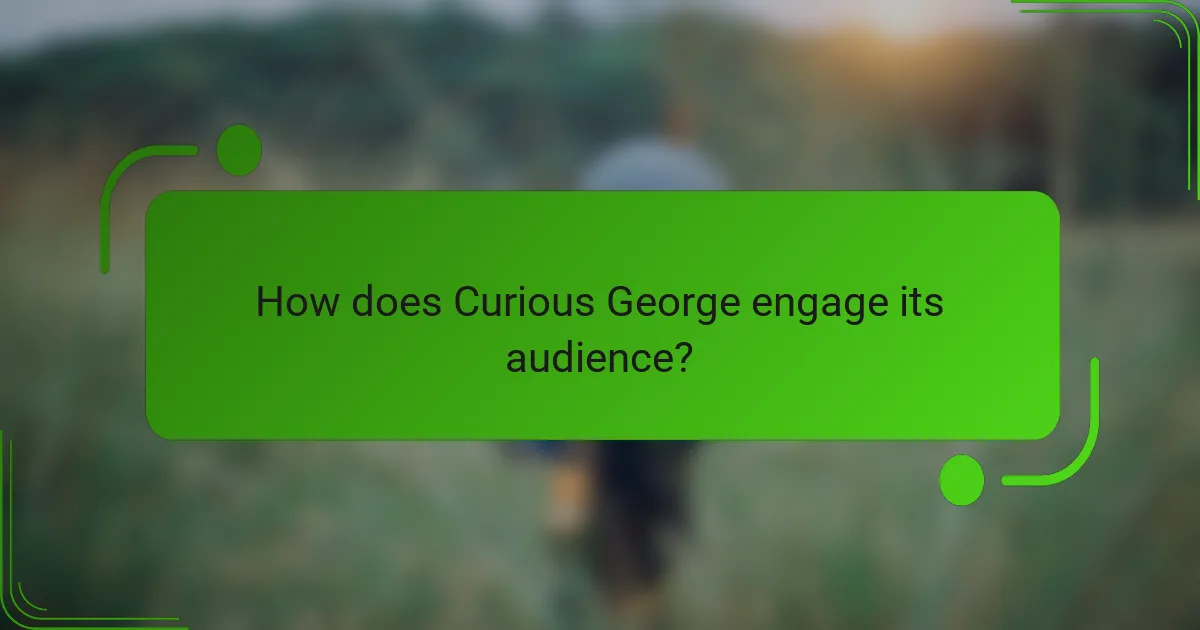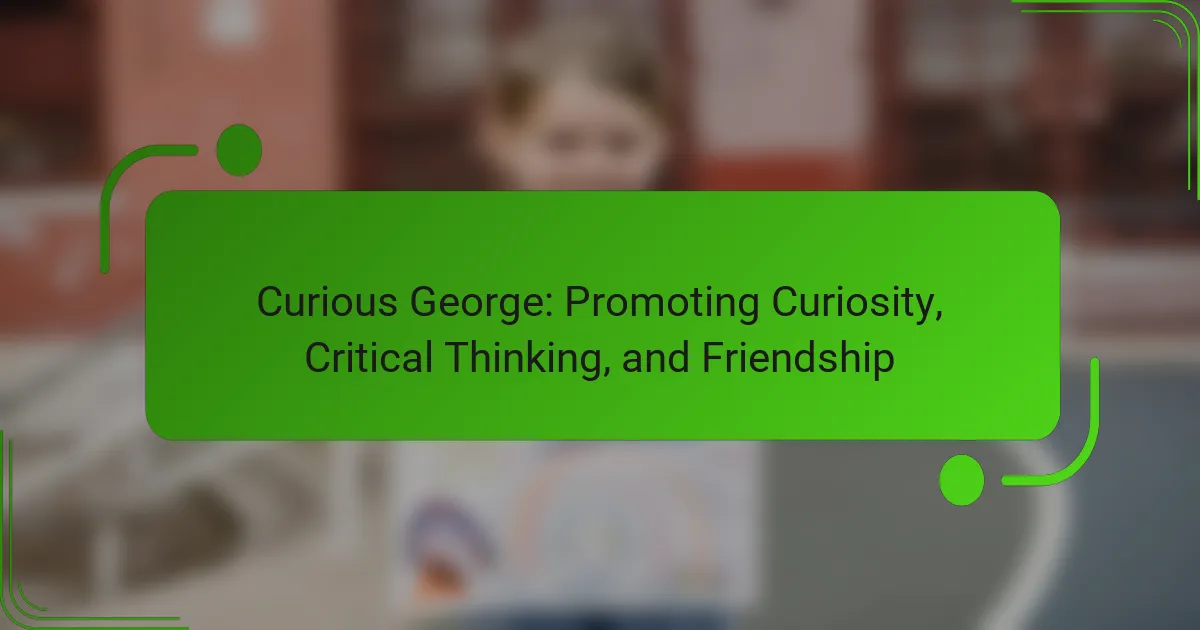Curious George is a fictional character created by H.A. Rey and Margret Rey, first introduced in a children’s book published in 1941. This small, playful monkey is characterized by his insatiable curiosity, leading him into various amusing situations that emphasize exploration and problem-solving. The narratives surrounding Curious George promote critical thinking, friendship, and cooperation, making them relatable and engaging for young readers. The series not only entertains but also serves as an educational tool, fostering inquiry-based learning and social development through its themes. Overall, Curious George plays a significant role in encouraging curiosity and enhancing social understanding among children.

What is Curious George?
Curious George is a fictional character in a series of children’s books. He is a small, playful monkey known for his curiosity. The character was created by H.A. Rey and Margret Rey. The first book featuring Curious George was published in 1941. Since then, he has appeared in numerous books, television shows, and films. Curious George often finds himself in amusing situations due to his inquisitive nature. The stories emphasize themes of exploration and problem-solving. This character promotes curiosity, critical thinking, and friendship among young readers.
How did Curious George originate?
Curious George originated from the creative minds of Hans Augusto Rey and Margret Rey. They were a husband-and-wife duo who wrote and illustrated the series. The character was first introduced in the book “Curious George,” published in 1941. The Reys originally created the character in Europe before fleeing to the United States during World War II. The books feature a curious little monkey and his adventures, emphasizing themes of curiosity and friendship. The series has since expanded into numerous books, television shows, and merchandise, making Curious George a beloved figure in children’s literature.
Who created the Curious George character?
The Curious George character was created by Hans Augusto Rey and Margret Rey. They were a husband-and-wife team. The Reys first introduced Curious George in 1941. The character appeared in the book “Curious George.” This book was published by Houghton Mifflin. The Reys were originally from Germany. They fled to the United States during World War II. Their unique background influenced the character’s charm and curiosity.
What is the story behind Curious George’s creation?
Curious George was created by Hans Augusto Rey and Margret Rey. The couple, originally from Germany, fled to Paris during World War II. They developed the character of Curious George while living in Paris. The first book featuring George was published in 1941. The Reys’ experiences and observations of a mischievous monkey inspired the character. Curious George quickly became popular among children and adults alike. The series has sold millions of copies worldwide. It has also been adapted into television shows and films, further expanding its reach and influence.
What themes are prevalent in Curious George stories?
Curious George stories prominently feature themes of curiosity, friendship, and problem-solving. The character George embodies curiosity as he explores the world around him. His adventures often lead to unexpected challenges that require critical thinking. Friendship is highlighted through George’s interactions with the Man in the Yellow Hat. Together, they navigate various situations, showcasing teamwork and support. The stories encourage young readers to embrace curiosity and learn from mistakes. They also illustrate the importance of companionship in overcoming obstacles. These themes contribute to the educational value of the series, fostering a love for learning in children.
How does Curious George promote curiosity?
Curious George promotes curiosity by encouraging exploration and problem-solving. The character’s adventures often involve discovering new things in everyday life. Each episode presents challenges that require George to think critically and ask questions. This approach engages young viewers and inspires them to be inquisitive. The narrative structure emphasizes learning through trial and error. Research shows that children exposed to such content develop stronger curiosity skills. The series exemplifies how playful learning fosters a desire to explore the world.
In what ways does Curious George encourage critical thinking?
Curious George encourages critical thinking through problem-solving scenarios and exploration. The character often faces challenges that require creative solutions. Children observe George’s curiosity and learn to ask questions. The stories promote experimentation and hypothesizing outcomes. For example, George’s adventures often involve trial and error. This teaches kids to think about consequences and make decisions. Engaging with George’s stories fosters analytical skills. Research shows that interactive storytelling enhances cognitive development in young readers.
How are themes of friendship depicted in Curious George?
Themes of friendship in Curious George are depicted through George’s interactions with the Man with the Yellow Hat and other characters. Their bond showcases loyalty, support, and mutual learning. George often helps his friends, demonstrating kindness and teamwork. The series illustrates how friendship can lead to problem-solving and adventure. For example, in various episodes, George’s curiosity often leads to challenges that his friends help him overcome. This reinforces the idea that friends provide assistance and encouragement. Overall, the narrative emphasizes the importance of friendship in fostering growth and exploration.

How does Curious George engage its audience?
Curious George engages its audience through interactive storytelling and relatable characters. The series features a curious monkey who explores the world around him. This exploration encourages children to ask questions and seek answers. The narrative often includes problem-solving scenarios that promote critical thinking. Children can relate to George’s playful nature and his adventures. The use of humor and light-hearted situations keeps the audience entertained. Additionally, themes of friendship and cooperation resonate with young viewers. Overall, the engaging content fosters curiosity and learning among its audience.
What age group is Curious George aimed at?
Curious George is aimed at preschool-aged children, typically between the ages of 2 to 5 years. This age group is characterized by developing curiosity and a desire to explore the world. The stories and themes in Curious George are designed to engage young children through simple narratives and relatable experiences. Research indicates that early childhood literature can significantly impact cognitive and social development. Curious George’s adventures encourage curiosity, problem-solving, and friendship, aligning well with the developmental needs of this age group.
How does the content cater to young children’s learning?
The content caters to young children’s learning by using engaging storytelling and relatable characters. It presents educational themes through fun adventures that spark curiosity. Each episode encourages critical thinking by posing questions that invite children to solve problems alongside the characters. The use of humor and playful scenarios keeps children interested and attentive. Interactive elements, such as songs and games, reinforce learning concepts in a memorable way. Research shows that children learn effectively through play-based experiences, making this approach beneficial. Additionally, the emphasis on friendship teaches social skills and emotional intelligence, which are crucial for young learners.
What role does humor play in engaging the audience?
Humor plays a significant role in engaging the audience by capturing attention and fostering connection. It creates a relaxed atmosphere, encouraging openness and receptiveness. When humor is used effectively, it can enhance memory retention of the content presented. Research shows that humorous content is more likely to be shared and discussed, increasing audience participation. Additionally, humor can bridge gaps between diverse audience members, promoting inclusivity and relatability. In educational contexts, like “Curious George,” humor can stimulate curiosity and critical thinking among children. This engagement leads to a more interactive and enjoyable learning experience.
How are the stories structured to promote learning?
Stories in “Curious George” are structured to promote learning through engaging narratives and relatable situations. Each story follows a clear beginning, middle, and end, allowing children to easily follow the plot. The character of George often encounters challenges that require problem-solving and critical thinking. This structure encourages children to think about solutions as they anticipate George’s actions.
Additionally, the stories incorporate themes of curiosity and exploration, which stimulate a desire to learn. The use of simple language and repetition reinforces key concepts, making them memorable. Illustrations complement the text, aiding comprehension and retention. Overall, this structured approach fosters cognitive development and encourages a love for learning.
What narrative techniques are used in Curious George stories?
Curious George stories utilize several narrative techniques to engage readers. One primary technique is the use of simple, repetitive language. This approach aids in comprehension for young readers. Another technique is the incorporation of humor and playful situations. These elements create an entertaining experience that captures children’s attention. Additionally, the stories often employ a clear cause-and-effect structure. This structure helps children understand the consequences of George’s actions. Illustrations play a crucial role in the narrative as well. They visually complement the text, enhancing understanding and engagement. The combination of these techniques effectively promotes curiosity and critical thinking.
How does the visual style contribute to the storytelling?
The visual style of “Curious George” significantly enhances storytelling. Bright colors and playful illustrations engage young audiences. These elements create an inviting atmosphere that fosters curiosity. The simplicity of the characters allows for easy emotional connection. Visual humor complements the narrative, reinforcing key themes. For example, George’s expressive face conveys his emotions effectively. This visual approach supports comprehension of complex concepts. Research shows that visual storytelling aids in memory retention for children. Thus, the visual style plays a crucial role in effective storytelling within “Curious George.”

What impact has Curious George had on education and social development?
Curious George has significantly impacted education and social development. The character promotes curiosity and exploration, encouraging children to ask questions and seek answers. This aligns with educational principles that emphasize inquiry-based learning. The stories often depict problem-solving scenarios, fostering critical thinking skills in young readers. Additionally, Curious George illustrates themes of friendship and cooperation, teaching social skills and empathy. Research shows that engaging with such narratives can enhance social understanding in children. Overall, Curious George serves as a valuable tool for both educational and social development.
How can educators utilize Curious George in the classroom?
Educators can utilize Curious George in the classroom by incorporating his stories into lesson plans. The character encourages curiosity and exploration, which are essential for early learning. Teachers can use Curious George books to teach literacy skills, such as reading comprehension and vocabulary. Activities can include discussing the themes of friendship and problem-solving found in the stories.
Additionally, educators can create interactive lessons based on Curious George’s adventures. For example, they can organize hands-on science experiments that reflect George’s curiosity. This approach fosters critical thinking as students learn to ask questions and seek answers.
Using Curious George also promotes social-emotional learning. Discussions about George’s interactions can help students understand empathy and cooperation. Overall, these strategies create a dynamic learning environment that engages students effectively.
What activities can be inspired by Curious George stories?
Activities inspired by Curious George stories include arts and crafts, science experiments, and outdoor adventures. Children can create their own Curious George-themed artwork using various materials. They can also conduct simple science experiments that reflect George’s curiosity, such as growing plants or exploring magnets. Outdoor activities may involve scavenger hunts inspired by George’s adventures in nature. Storytelling sessions can encourage children to create their own narratives based on George’s experiences. Cooking activities can be inspired by George’s love for food, allowing kids to make simple recipes. Each of these activities promotes curiosity, critical thinking, and friendship among children.
How does Curious George foster social skills among children?
Curious George fosters social skills among children by presenting relatable social scenarios. The character often navigates friendships, sharing, and problem-solving. These interactions teach children the importance of empathy and cooperation. Episodes frequently showcase George learning from mistakes, emphasizing resilience. The stories encourage dialogue about feelings and reactions. This promotes critical discussions between children and caregivers. Engaging with George’s adventures allows children to practice social interactions in a safe context. Research shows that storytelling can enhance social understanding in early childhood.
What lessons can children learn from Curious George?
Children can learn several important lessons from Curious George. The character exemplifies curiosity and exploration. He encourages children to ask questions and seek answers. Through his adventures, children learn about problem-solving. George often faces challenges that require critical thinking. His experiences demonstrate the importance of perseverance. Children also see the value of friendship and teamwork. George’s interactions with others highlight empathy and cooperation. These lessons foster a growth mindset in young viewers.
How does Curious George teach problem-solving skills?
Curious George teaches problem-solving skills through engaging stories that showcase his adventures. Each episode presents a challenge that George must overcome. He often encounters obstacles that require creative thinking. The narrative encourages viewers to think critically about solutions. For instance, George uses trial and error to figure out how to achieve his goals. This process illustrates the importance of persistence in problem-solving. The show also emphasizes teamwork, as George often collaborates with others for solutions. By watching George’s experiences, children learn to approach problems with curiosity and resilience.
What moral lessons are conveyed through Curious George’s adventures?
Curious George’s adventures convey several moral lessons. One key lesson is the importance of curiosity and exploration. George’s inquisitive nature often leads him to discover new things. This encourages children to ask questions and seek knowledge. Another lesson is the value of friendship and helping others. George frequently assists his friends, demonstrating compassion and teamwork. Additionally, his misadventures highlight the importance of problem-solving. George learns from his mistakes, teaching resilience and adaptability. These themes are consistently illustrated throughout the series, reinforcing positive character traits in young readers.
What are some best practices for parents and educators using Curious George?
Parents and educators can enhance learning with Curious George by engaging children in discussions about the story. Encourage kids to ask questions about the characters and plot. Use hands-on activities related to the themes in the stories, such as science experiments or art projects. Incorporate lessons on problem-solving by discussing how Curious George resolves challenges. Reading aloud together can improve comprehension and foster a love for reading. Utilize episodes or books to teach social skills, like sharing and friendship. Encourage children to express their thoughts and feelings about the stories to develop critical thinking. These practices align with educational standards and promote curiosity and critical thinking skills in young learners.
Curious George is a fictional character created by Hans Augusto Rey and Margret Rey, featured in a series of children’s books that promote themes of curiosity, critical thinking, and friendship. The character’s adventures, which began with the first book published in 1941, engage preschool-aged children through relatable narratives that encourage exploration and problem-solving. The stories emphasize the importance of social skills, resilience, and teamwork, making Curious George a valuable educational tool for fostering cognitive and emotional development in young readers. Additionally, the series utilizes humor and interactive storytelling techniques to enhance engagement and learning outcomes.
